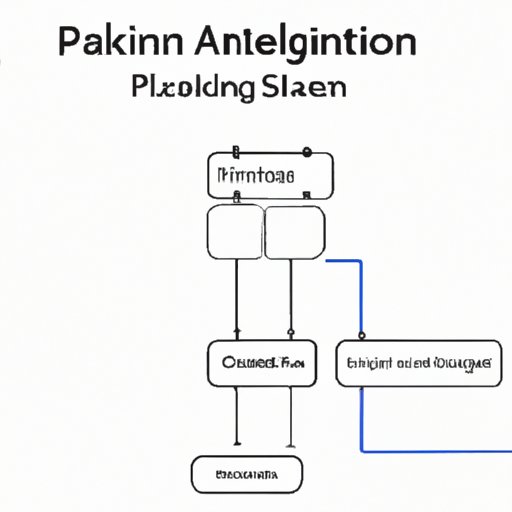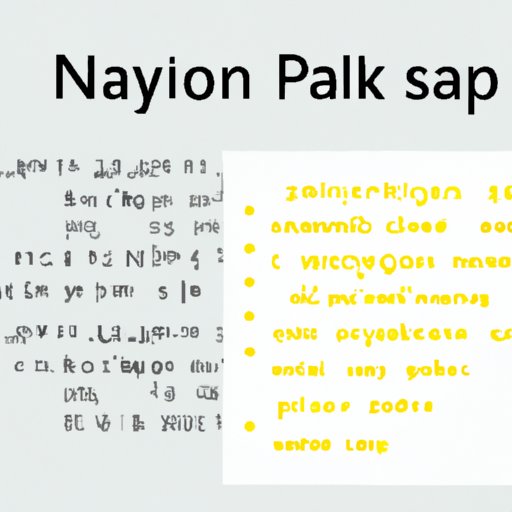Introduction
Artificial Intelligence (AI) is a field of technology that focuses on making machines that can think and act like humans. AI has been around since the 1950s, but recent advances in computing power have made it possible to create more sophisticated AI systems. As AI continues to evolve, it will become increasingly important for developers to understand how to make use of this technology. Python is one of the most popular programming languages used for AI development, and this article will explore how to make an AI with Python.

Exploring the Basics of AI and Python
Before diving into the specifics of AI development with Python, it is important to have a basic understanding of both AI and Python. AI is a broad field of study that encompasses many different concepts and techniques. At its core, AI is focused on making machines that can think, learn, and act like humans. This includes tasks such as recognizing objects, understanding speech, making decisions, and solving problems.
Python is a high-level, interpreted programming language that is widely used for developing AI applications. Python is easy to learn and use, and it is well-suited for AI development due to its extensive library of packages and modules. Python also offers excellent support for data structures, which are essential for AI development.
Utilizing Libraries for AI Development with Python
Python offers a wide range of libraries and packages that can be used for AI development. These libraries provide a set of functions and classes that allow developers to quickly and easily build AI applications. Popular libraries for AI development include SciPy, Numpy, Pandas, TensorFlow, and Scikit-learn.
SciPy is a Python library that provides a number of mathematical and scientific functions. It is used for numerical computation and data analysis, and it is particularly useful for AI development due to its support for linear algebra, Fourier transforms, and optimization algorithms.
Numpy is a powerful library for scientific computing in Python. It provides support for multi-dimensional arrays and matrices, and it is used for numerical and scientific computing. Numpy is often used for image processing and machine learning applications.
Pandas is a library that provides data structures and data analysis tools for Python. It is used for data manipulation, analysis, and visualization. Pandas is often used for data preprocessing and feature engineering, which are important steps in AI development.
TensorFlow is a library for machine learning and deep learning. It is used for building and training neural networks, and it is a popular choice for AI development due to its ability to efficiently process large datasets.
Scikit-learn is a library for machine learning in Python. It provides a variety of algorithms for classification, regression, clustering, and dimensionality reduction. Scikit-learn is a popular choice for AI development due to its ease of use and efficient implementation.

Designing Algorithms for AI with Python
Algorithms are an essential part of AI development, as they provide the instructions for how a machine should behave. Algorithms are used to identify patterns in data, classify objects, make predictions, and solve problems. There are a variety of different algorithms used in AI, including decision trees, support vector machines, and genetic algorithms.
Developers must have a good understanding of algorithms in order to design effective AI systems. When designing algorithms for AI, developers should consider factors such as accuracy, scalability, and efficiency. Additionally, developers should consider the tradeoffs between speed and accuracy when designing algorithms.
Developing Artificial Neural Networks with Python
Artificial neural networks are a type of algorithm used in AI. They are inspired by the neurons in the human brain, and they are used for pattern recognition, classification, and prediction. Neural networks are composed of layers of interconnected nodes, and each node contains a set of weights that determine how the network behaves.
Python offers several libraries for developing neural networks, such as Keras and PyTorch. These libraries provide a set of functions and classes that allow developers to quickly and easily build neural networks. Developers can use these libraries to build and train neural networks for a variety of tasks, such as image recognition and natural language processing.

Building Machine Learning Models with Python
Machine learning is a subset of AI that focuses on building models that can learn from data. Machine learning models are used for a variety of tasks, such as classification, regression, clustering, and recommendation systems. Python offers a variety of libraries for building machine learning models, such as scikit-learn and TensorFlow.
When building machine learning models, developers must consider factors such as accuracy, scalability, and complexity. Additionally, developers should consider the tradeoffs between speed and accuracy when creating models. Finally, developers should optimize their models using techniques such as hyperparameter tuning and regularization.
Creating Natural Language Processing Applications with Python
Natural language processing (NLP) is a subfield of AI that focuses on understanding and generating human language. NLP is used for a variety of tasks, such as text classification, sentiment analysis, and machine translation. Python offers a variety of libraries for developing NLP applications, such as NLTK and spaCy.
When creating NLP applications, developers must consider factors such as accuracy and scalability. Additionally, developers should consider the tradeoffs between speed and accuracy when creating applications. Finally, developers should optimize their applications using techniques such as feature engineering and hyperparameter tuning.

Implementing Computer Vision with Python
Computer vision is a subfield of AI that focuses on understanding and interpreting images. Computer vision is used for a variety of tasks, such as object recognition, image classification, and facial recognition. Python offers a variety of libraries for developing computer vision applications, such as OpenCV and SimpleCV.
When implementing computer vision applications, developers must consider factors such as accuracy, scalability, and complexity. Additionally, developers should consider the tradeoffs between speed and accuracy when creating applications. Finally, developers should optimize their applications using techniques such as feature engineering and hyperparameter tuning.
Conclusion
In summary, this article has covered the basics of AI and Python programming, libraries for AI development, algorithms, neural networks, machine learning models, natural language processing applications, and computer vision implementation. With the right knowledge and tools, developers can create powerful AI applications using Python.
(Note: Is this article not meeting your expectations? Do you have knowledge or insights to share? Unlock new opportunities and expand your reach by joining our authors team. Click Registration to join us and share your expertise with our readers.)
